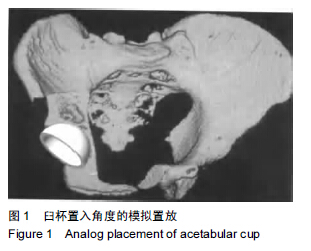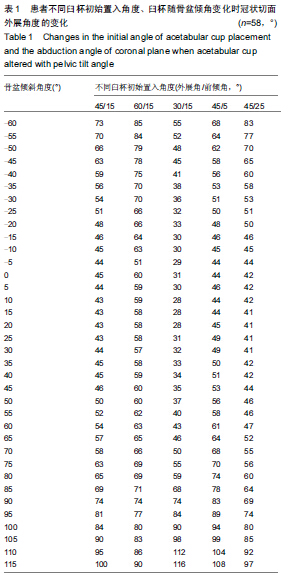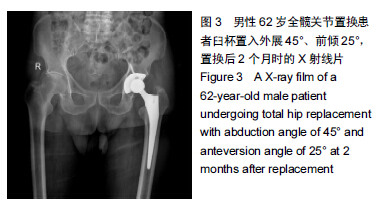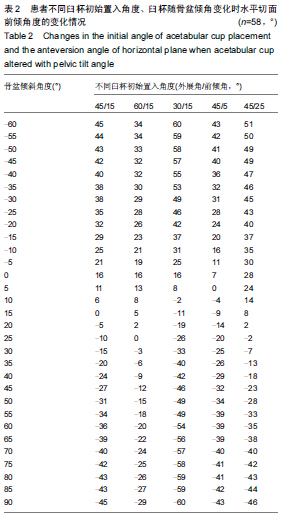[2] 刘剑伟,蒋卫平.全髋置换术与半髋置换术治疗股骨颈骨折的疗效对比[J].实用骨科杂志,2013,19(8):747-749.
[3] 范义平,陈恩祥,蒋泰媛,等.半髋与全髋置换术治疗老年股骨颈骨折的疗效比较[J].中国老年学杂志,2012,32(22): 4996-4997.
[4] 李晓莉.人工全髋关节置换术后患者的围术期护理[J].实用临床医药杂志,2014,18(24):209,211.
[5] 丁冠男,李树人,潘振祥,等.巴曲亭对低分子肝素抗凝全髋置换术患者出血量及凝血功能影响的研究[J].中华流行病学杂志,2014, 35(6):737-740.
[6] 刘丽华.全髋置换术的临床护理和并发症的防治[J].中国实用护理杂志,2014,30(z2):41-42.
[7] 邓丽娟,胡保红,麦瑶,等.临床路径在全髋置换术后康复指导中的应用体会[J].中国美容医学,2012,21(z2):194-195.
[8] 向艾娥.高龄患者人工髋关节置换术围手术期护理[J].现代中西医结合杂志,2011,20(1):95-96.
[9] 施伟业.全髋置换术中微创后外侧小切口的应用分析[J].临床和实验医学杂志,2013,12(3):199-200,203.
[10] 任玉柱,张殿成,李磊,等.全髋置换术295例并发症的预防与治疗[J].中国误诊学杂志,2010,10(13):3169-3170.
[11] 王史潮,徐仲翔,安漫红,等.股骨头坏死后骨盆倾斜角度对人工髋关节置换后功能的影响[J].中国中西医结合外科杂志,2015,(1): 26-28.
[12] 吴重祥.髋臼杯的外展角和前倾角与全髋置换术后脱位的关系[D].福建医科大学,2011.
[13] 张振华,孙付杰,胡克正,等.头颈比不同人工髋关节臼杯安置角度的安全范围[J].中国组织工程研究,2014,(35):5589-5594.
[14] 赵赞栋,王健,肖军,等.髋关节骨性关节炎及髋臼发育不良对髋关节表面置换术中髋臼安装角度的影响[J].中国矫形外科杂志, 2011,19(17):1435-1437.
[15] 李冬松,李叔强,齐欣,等.非骨水泥型臼杯位置对植入假体髋臼内应力分布的影响[J].中国组织工程研究与临床康复,2007,11(40): 8209-8212.
[16] 戴雪松,严世贵,何荣新,等.全髋关节置换术中的髋臼外展角和磨损的关系[J].中华骨科杂志,2002,22(5):257-260.
[17] 周康华,傅朝文.瑞芬太尼控制性降压联合急性等容血液稀释在全髋置换术中的应用[J].重庆医学,2013,42(11):1292-1294.
[18] 胡德炜,李新忠,宋勇,等.比较后外侧微创切口全髋置换术与常规全髋置换术临床疗效[J].中国医疗前沿,2013,(22):50-50,51.
[19] 李清平,吴红利.不同麻醉方式对老年人全髋置换术后下呼吸道感染的影响[J].浙江医学,2014,36(12):1091-1124.
[20] 黄金凤.等比重罗哌卡因符合舒芬太尼腰硬联合麻醉在全髋置换术中的应用[J].山东医药,2014,54(8):75-77.
[21] 李永旺,何荣丽,白晓亮,等.全髋资环是否重建偏心距对髋关节功能的影响[J].中国组织工程研究,2014,18(4):505-510.
[22] 汪强,孙俊英,金晖,等.S-ROM股骨柄假体的设计特征与初次全髋置换[J].中国组织工程研究,2012,16(17):3061-3064.
[23] 李旭,尚希福,张文志,等.全髋置换术对髋-脊综合征患者下腰痛症状影响的相关研究[J].安徽医学,2012,33(4):418-420.
[24] 包欣南,张乃东,黄智慧,等.金属大头全髋置换术的早期疗效观察[J].江苏大学学报(医学版),2010,20(6):541-542,545.
[25] 丁登峰,蔡兴涛,白智萍,等.罗哌卡因局部浸润符合患者自控静脉镇痛用于全髋置换术的效果[J].广东医学,2013,34,(21): 3314-3316.
[26] 马小菊.高龄患者人工全髋置换术的围手术期护理[J].中国实用护理杂志,2012,28(z1):28.
[27] 施伟业.全髋置换术中微创后外侧小切口的应用分析[J].临床和实验医学杂志,2013,12(3):199-203.
[28] 何志勇,狄正林,陶崑,等.全髋表面置换术和传统全髋置换术术后生物力学结构恢复的比较研究[J].临床骨科杂志,2011,14(5): 492-495.
[29] 刘彬,姚爱军,冯祝余,等.适度控制性江雅联合术中自体血回输对老年全髋置换术患者的血液保护[J].实用医学杂志,2014,30(18): 2936-2938.
[30] 黄德辉,韩琪,刘存云,等.腰硬联合麻醉在老年患者全髋置换术中的临床应用[J].现代中西医结合杂志,2012,21(20): 2248-2249.
[31] 杨士鹏,金蕴,李成福.两种常用假体在全髋置换术中应用临床效果的Meta分析[J].中国医学科科学院,2013,35(6):672-676.
[32] Clarke IC, Kubo K, Donaldson TK,等.通过取出物研究回顾采用28 mm和32 mm直径假体的全髋关节置换术[J].中华关节外科杂志(电子版),2010,4(3):397-403.
[33] 袁晓燕.老年患者人工全髋关节置换术27例围手术期护理[J].实用医学杂志,2010,26(9):1656-1658.
[34] 金波,徐芳,许小梅,等.强直性脊柱炎患者行全髋置换术的护理体会[J].浙江中医药大学学报,2010,34(6):934,938.
[35] 褚亚明,周一新,寇玉辉,等.股骨转子下截骨全髋置换术治疗 Hartofilakidis C1和 C2型髋关节发育不良的对比研究[J].北京大学学报(医学版),2015,47(2):232-236.
[36] 徐利明,朱炳斌,蒋毅,等.全髋关节置换术后早期后脱位的原因分析[J].中国骨伤,2010,23(3):187-188.
[37] 刘兴炎,高秋明,樊晓海,等.高龄患者髋臼发育不良全髋置换术的围手术期准备与疗效分析[J].中国矫形外科杂志,2010,18(9): 705-708.
[38] 张细姣,许跃珍,秦柳珍,等.老年患者全髋置换术后康复中量化训练的应用[J].中医正骨,2010,22(4):76-77.
[39] 李永奖,蔡春元,张力成,等.满足日常生活活动范围的髋臼假体角度安全范围及杯颈前倾角组合[J].中国骨伤,2011,24(11): 930-934.
[40] 张江涛,尚延春,吴富源,等.髋关节假体置换中股骨头直径及髋臼前倾角的作用[J].中国组织工程研究,2013,17(30):5427-5433.




